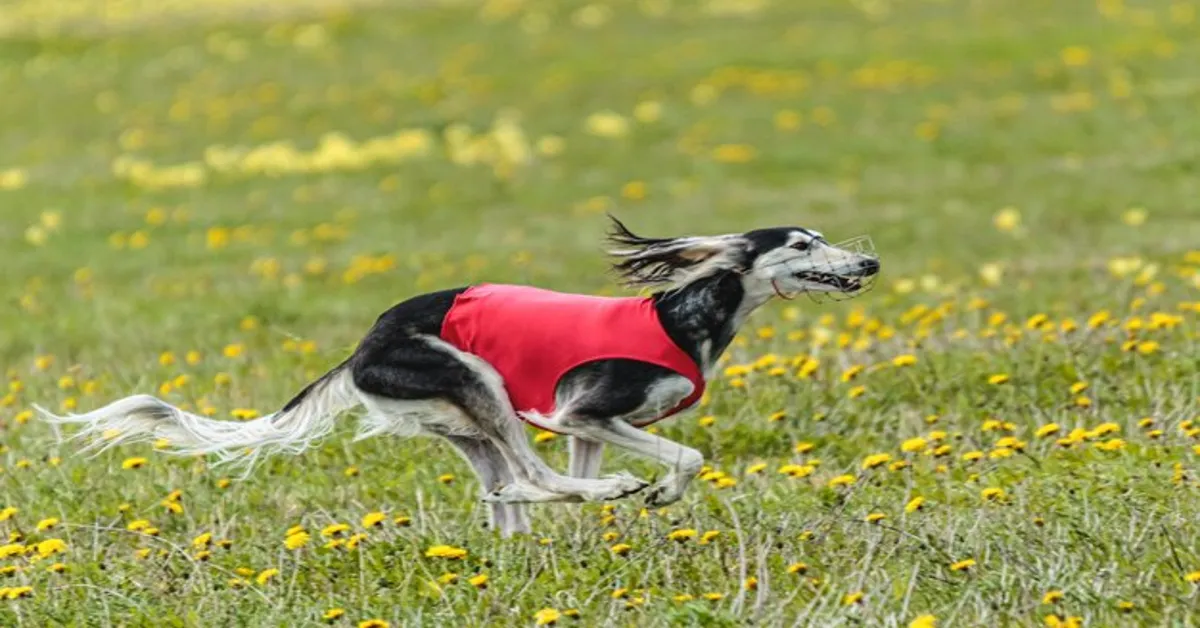If you’re searching for a unique and affectionate breed, the Silken Windhound might just be your perfect match. With their elegant appearance and gentle temperament, these dogs have captured the hearts of many dog lovers around the world. But there’s more to this enchanting breed than meets the eye! Join us on a journey as we explore the history, characteristics, and essential care tips of the Silken Windhound. Whether you’re already enchanted by this graceful hound or simply curious about them, you’ll find valuable insights to help deepen your appreciation for this remarkable breed.
Silken Windhound Overview
The Silken Windhound is a relatively new breed, known for its striking elegance and friendly nature. These dogs are a sight to behold, with their flowing coats and graceful movements that hint at their sighthound heritage.
Originally bred in the late 20th century, they were developed for companionship and performance. Their gentle disposition makes them ideal family pets while still possessing an athletic spirit perfect for various dog sports. With their charm and intelligence, Silken Windhounds can easily win you over.
Appearance
The Silken Windhound is a graceful dog, known for its elegant silhouette and flowing coat. Standing between 18 to 24 inches tall, they have a slender build that exudes both speed and agility. Their long necks lead to refined heads with expressive eyes that can be any shade.
Their fur is soft and silky, often featuring a variety of colors and patterns. The combination of their delicate features and powerful stature makes them truly captivating in appearance. They embody beauty with athleticism wrapped into one stunning package.
Temperament
The Silken Windhound is known for its gentle and friendly nature. These dogs are affectionate with their families and tend to get along well with children and other pets. Their calm demeanor makes them great companions.
While they have a playful side, Silken Windhounds also enjoy downtime and relaxation. They bond closely with their owners, often seeking companionship throughout the day. This breed’s easy-going temperament allows them to adapt well to various living situations, whether in an apartment or a house with a yard.
History of the Silken Windhound
The Silken Windhound emerged in the late 20th century, created by crossing several breeds, including the Whippet and Borzoi. The goal was to produce a versatile companion dog that excelled in both performance and companionship.
This breed quickly gained popularity for its grace and charm. As an agile sight hound, it became known for its speed during lure coursing events. Enthusiasts recognized the unique qualities of the Silken Windhound, fostering a strong community dedicated to preserving its lineage and characteristics.
Historical Background
The Silken Windhound has a rich lineage that traces back to the ancient sighthounds of Persia and Europe. Developed in the late 20th century by breeders seeking a smaller, more manageable alternative to traditional sighthounds, this breed emerged with distinct grace and elegance.
Their popularity grew as enthusiasts appreciated their speed and agility. These dogs were bred for companionship as well as performance, resulting in a unique blend of athleticism and affection that continues to attract dog lovers today.
Traits of the Silken Windhound
The Silken Windhound is known for its graceful elegance and athletic build. Their long, flowing coat gives them a distinct appearance that captures attention wherever they go. With a gentle expression in their eyes, these dogs exude warmth and friendliness.
Beyond looks, Silken Windhounds are affectionate and loyal companions. They bond closely with their families and thrive on social interaction. This breed is also intelligent and eager to please, making them responsive learners who enjoy training sessions. Their playful nature adds joy to any household setting.
Physical Attributes
The Silken Windhound is an elegant sight to behold. These dogs have a refined, slender build that exudes grace and agility. Their long legs support a lightweight frame, allowing for impressive speed and movement.
Their coat is one of their standout features—silky, soft, and flowing. It comes in various colors and patterns, enhancing their striking appearance. With expressive eyes and gentle facial features, the Silken Windhound captures hearts effortlessly with its charm and beauty.
Behavioral Characteristics
Silken Windhounds are known for their affectionate and gentle nature. They thrive on human companionship, forming strong bonds with their families. This breed is often playful and enjoys engaging in various activities.
Despite their spirited demeanor, they can also exhibit a calm side, making them suitable for both active and relaxed households. Silken Windhounds are intelligent and eager to please, which makes training an enjoyable experience. Their friendly disposition means they typically get along well with other pets and children too.
Training and Exercise Needs
Silken Windhounds thrive on mental and physical stimulation. Regular training sessions help them develop good manners and obedience. Positive reinforcement works wonders, as these dogs respond well to encouragement.
Exercise is vital for their health and happiness. Daily walks, playtime in a secure yard, or engaging in lure coursing keep them active. These graceful hounds love to run, so providing opportunities for sprinting will satisfy their instincts while strengthening your bond with them.
Training Guidelines
Training a Silken Windhound requires patience and consistency. These dogs are intelligent and eager to please, making them receptive learners. Start with basic commands like sit, stay, and come. Use positive reinforcement techniques such as treats or praise.
Keep training sessions short but engaging, around 10-15 minutes each. Incorporate fun activities that stimulate their minds and bodies. Socialization is crucial; expose your Silken Windhound to various environments, people, and other pets early on to build confidence and adaptability in different situations.
Exercise Requirements
Silken Windhounds are energetic and agile, requiring regular exercise to stay healthy and happy. Daily walks, playtime in a secure yard, or engaging in lure coursing can help meet their activity needs.
These dogs thrive on mental stimulation too. Interactive games and training sessions keep their minds sharp while strengthening the bond with their owners. Aim for at least an hour of exercise each day to ensure your Silken Windhound remains fit and content throughout its life.
Health and Grooming
The Silken Windhound is generally a healthy breed, but they can be prone to specific conditions like hip dysplasia and certain heart issues. Regular vet check-ups help in early detection of any health concerns. Keeping an eye on their weight is crucial to prevent obesity-related problems.
Grooming these dogs is relatively simple due to their short, silky coat. A weekly brushing keeps shedding at bay and maintains their coat’s shine. Occasional baths are sufficient, along with regular dental care to ensure optimal hygiene and overall health.
Health Conditions
Silken Windhounds are generally healthy dogs but can be prone to certain health conditions. Some common issues include hip dysplasia, eye disorders, and certain hereditary diseases. Regular check-ups with a veterinarian are essential for early detection.
Maintaining a healthy lifestyle plays a crucial role in their well-being. Proper nutrition, regular exercise, and routine veterinary care help minimize risks associated with these conditions. Being attentive to symptoms can lead to prompt treatment and better quality of life for your Silken Windhound.
Grooming Tips
Grooming your Silken Windhound is essential to keep their coat healthy and radiant. Regular brushing, ideally once a week, helps remove loose fur and prevents matting. Use a slicker brush or comb designed for long-haired breeds.
Bathing should be done sparingly—about every two to three months unless they get particularly dirty. When you do bathe them, use a gentle dog shampoo that won’t strip natural oils from their skin. Don’t forget to check their ears and trim their nails regularly for optimal health.
Silken Windhound Care Tips
Proper nutrition is essential for your Silken Windhound. Choose a high-quality dog food rich in protein and healthy fats to support their active lifestyle. Adjust portions based on age, weight, and activity levels to maintain a healthy body condition.
Regular veterinary check-ups are important for monitoring health. Keep up with vaccinations and preventative care. Maintain a consistent grooming routine to keep their coat shiny and free from tangles. Spend quality time with them, as they thrive on companionship and love engaging activities that stimulate their mind.
Nutrition
Proper nutrition is crucial for the health of your Silken Windhound. These dogs thrive on high-quality dog food that meets their specific needs. Look for options rich in protein, healthy fats, and essential vitamins.
It’s also important to monitor portion sizes based on their age, weight, and activity level. Fresh water should always be available to keep them hydrated. Occasional treats are fine but opt for healthy choices like fruits and vegetables to maintain a balanced diet without excess calories.
General Care Guidelines
To ensure your Silken Windhound thrives, establish a consistent routine. Regular vet check-ups are essential for monitoring health and catching any potential issues early. Create a safe space at home where they can relax and feel secure.
Socialization is crucial; expose them to various environments, people, and other pets from an early age. This helps in shaping their friendly demeanor. Provide mental stimulation through interactive toys or puzzles to keep their minds sharp.
A well-balanced diet tailored to their specific needs supports overall health. Fresh water should always be available. Maintain a positive relationship with regular affection and attention; this strengthens your bond and promotes happiness in your Silken Windhound’s life.









